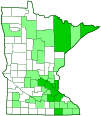Common Bonnet
(Mycena galericulata)
Conservation • Description • Habitat • Ecology • Distribution • Taxonomy
Conservation Status |
|
|||||||
| IUCN Red List | not listed |
|||||||
| NatureServe | NNR - Unranked |
|||||||
| Minnesota | not listed |
|||||||
Description |
||
Mycena is a large genus with many nondescript brown mushrooms, and Common Bonnet is one of them. Distinguishing between them in the field is difficult. Common Bonnet is a medium-sized gilled mushroom but a large bonnet mushroom. Its comparatively large size is one of the distinguishing features of this species. It occurs in Europe, Asia, and the Americas, and there are a few scattered records from Africa. Records from Australia are believed to be misidentifications. In the United States it occurs east of the Great Plains and west of the Rocky Mountains, with just scattered records between. It is found in spring and fall, usually in clusters, sometimes alone or scattered. It grows on well decayed hardwood stumps, logs, and debris. When it appears on the ground it is growing on wood buried in the ground. It obtains its nutrients from decaying wood (saprobic). When it first appears, the cap is cone-shaped or bell-shaped and dark brown. The upper surface is hairless and moist or greasy but not sticky. Shallow grooves radiate from the center to the margins. The margins are curved inward. As it ages the cap flattens out and the color fades. The mature cap is broadly bell-shaped, broadly convex, or flat, usually with a pronounced bump in the center (umbonate). It is usually ¾″ to 2″ (1.8 to 5 cm) in diameter, sometimes up to 2¾″ (7 cm) in diameter. It is brown, grayish-brown, or yellowish-brown, dark in the center, and fading toward the margins. The upper surface is hairless and moist or greasy and shallowly radially lined. The margins are spread out, often turned upward, and sometimes split. The cap does not develop dark stains with age. The gills are closely spaced. There are 22 to 39 main gills, and between the main gills there are one to three series of short gills that do not extend to the stalk. There are also numerous prominent cross-veins that connect adjacent gills together. The main gills are narrowly attached to the stalk, usually with a short tooth that extends slightly down the stalk. All of the gills are whitish or pale whitish-gray at first, becoming pinkish with age. They do not change color when bruised, and do not develop dark stains with age. The stalk is slender, cartilaginous, and hollow. It is whitish above, light brown to dark brown below, and usually 2″ to 4″ (5 to 10 cm) long, but it can be up to 5½″ (14 cm) long. It is ⅛″ to ¼″ (2.5 to 6.5 mm) thick, equally thick from top to bottom. There are often root-like, up to 2⅜″ (6 cm) long filaments (radicles) on the lower portion. The base is more or less densely covered with whitish fibers (fibrils). The stalk does not develop dark stains with age. The flesh is thin and whitish or pale gray. It does not change color when sliced. When crushed it has a slightly mealy odor. It is not poisonous, but eating it is not recommended due to its similarity to many other mushrooms whose edibility is not known. |
||
Similar Species |
||
Clustered Bonnet (Mycena inclinata) develops reddish-brown stains with age on the cap, gills, and stalk. When young, the margins of the cap are toothed. The stalk is yellow above and reddish-brown below. The flesh has a strong mealy odor when crushed. |
||
Habitat and Hosts |
||
Deciduous and mixed woodlands. Stumps, logs, and debris of hardwoods. |
||
Ecology |
||
Season |
||
Spring and fall |
||
Distribution |
||||
|
Sources With one exception, each of the sources above show Mycena galericulata as uncommon in Minnesota, with few records, all of them limited to the southeast quarter of the state. iNaturalist, a popular site that accepts observations from the general public, has many uncomfirmed records of Mycena galericulata from all over the state. Mycena is a large genus with many nondescript brown mushrooms. Given the difficulty of distinguishing Mycena galericulata in the field from close look-alikes, and the lack of confirmation from other sources, most of the records from iNaturalist are probably misidentifications. The counties in light green on the map at left have only uncomfirmed records on iNaturalist. |
|||
| 8/3/2023 | ||||
Occurrence |
||||
Common |
||||
Taxonomy |
|||
| Kingdom | Fungi (Fungi) | ||
| Subkingdom | Dikarya | ||
| Phylum | Basidiomycota (Basidiomycete Fungi) | ||
| Subphylum | Agaricomycotina (Higher Basidiomycetes) | ||
| Class | Agaricomycetes (Mushrooms, Bracket Fungi, Puffballs, and Allies) | ||
| Subclass | Agaricomycetidae | ||
| Order | Agaricales (Common Gilled Mushrooms and Allies) | ||
| Suborder | Marasmiineae | ||
Family |
Mycenaceae | ||
Genus |
Mycena (bonnets) | ||
Synonyms |
|||
Agaricus conicus Agaricus crispus Agaricus galericulatus Prunulus galericulatus Stereopodium galericulatum |
|||
Common Names |
|||
Common Bonnet Common Mycena Rosy-gill Fairy Helmet Toque Mycena |
|||
Glossary
Saprobic
A term often used for saprotrophic fungi. Referring to fungi that obtain their nutrients from decayed organic matter.
Umbonate
On mushrooms, having a distinct, raised, knob-like projection in the center of the cap.
Visitor Photos |
|||||
Share your photo of this fungus. |
|||||
| This button not working for you? Simply email us at info@MinnesotaSeasons.com. Attach one or more photos and, if you like, a caption. |
|||||
Honey Fae (Farah) |
|||||
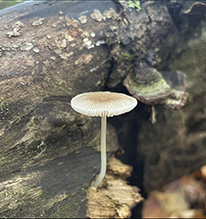 |
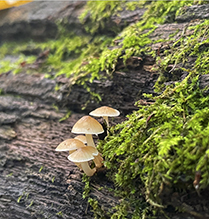 |
||||
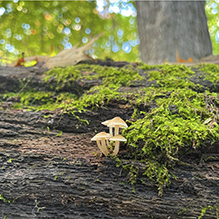 |
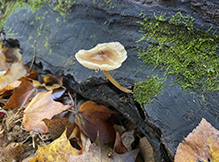 |
||||
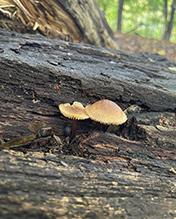 |
|||||
MinnesotaSeasons.com Photos |
|||||
|
|||||

Slideshows |
||

Visitor Videos |
|||
Share your video of this fungus. |
|||
| This button not working for you? Simply email us at info@MinnesotaSeasons.com. Attach a video, a YouTube link, or a cloud storage link. |
|||
Other Videos |
|||
| Rosablaettriger Helmling, Mycena galericulata PILZWELTEN |
|||
About
May 24, 2019 |
|||
| Fantastic Fungi: Common Bonnet Mill Creek MetroParks |
|||
About
Sep 1, 2022 The Education Department is offering a new series entitled, “Fantastic Fungi” Parks and Resource Conservationist and MCMP Educator Katelinn Bowser will be your host. Please remember, the removal of vegetation from Park district property is prohibited. WARNING: Some wild mushrooms can be poisonous and caution should be taken when consuming. |
|||

Created: 12/25/2022
Last Updated:
